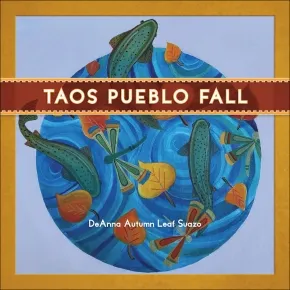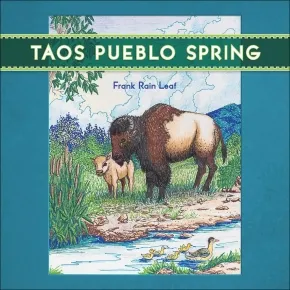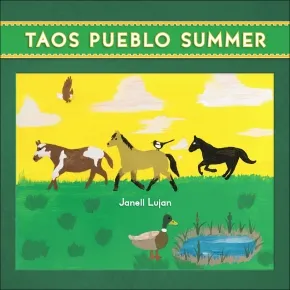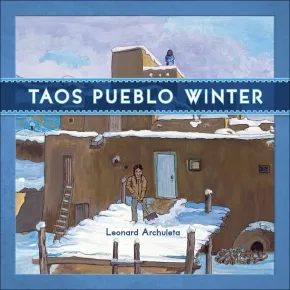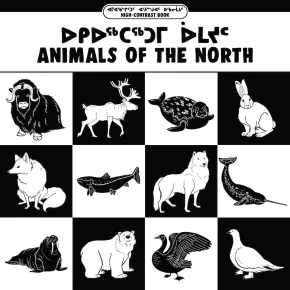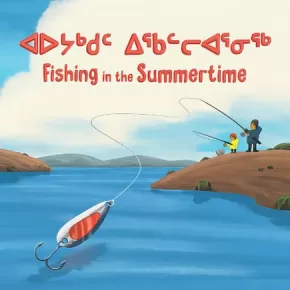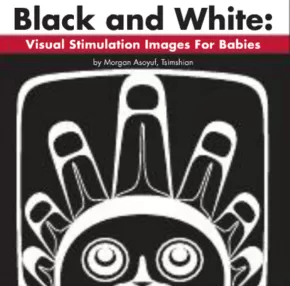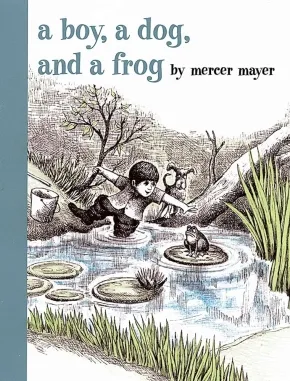
Wordless Books
1
-
9
of
9 Results;
Sort By
Wordless books promote pre-reading skills — prediction, comprehension, sequencing, inferring and visual literacy — and are useful for classrooms with English-language learners.
Taos Pueblo Fall (BB)
$14.95
Artists:
Format:
Board Book
Text Content Territories:
Indigenous American; Native American; Taos Pueblo;
Grade Levels: Preschool;
ISBN / Barcode: 9781570673917
Synopsis:
Synopsis:
This delightful board book, written without text, was created by the Taos Pueblo's Tiwa Language Program to preserve the Tiwa culture and revitalize the Tiwa language by teaching it to younger generations. Many other Indigenous languages also need revitalizing, so it is the hope of the Taos Pueblo's Tiwa Language Program that other American Indian Nations will find the books in the Toas Pueblo Four Seasons series useful to teach their language to young children. The beautiful, hand-drawn illustrations will also teach young children about the four seasons of the year. All proceeds of the book support the Taos Pueblo's Tiwa Language Program.
This text-free board book allows Indigenous nations to teach their own languages to children.
Educator & Series Information
This wordless book is part of the Taos Pueblo Four Seasons series.
We are the "Red Willow People" of Taos Pueblo and have sustained our ancient village as one of the longest continuously inhabited communities, for over 1,000 years. Taos Pueblo is located in northern New Mexico and our Tiwa language is a dialect of the Tanoan language, which is not a written language. Traditionally we learn our Tiwa Language through oral tradition but we are in danger of losing our ancient language due to colonization, modernization, and the shift from Tiwa as our first language to English as our first language. The efforts of the Taos Pueblo Tiwa Language Program are focused on revitalizing the Tiwa Language and culture by protecting and preserving it, through teaching it to our younger generations.
This text-free board book allows Indigenous nations to teach their own languages to children.
Additional Information
22 pages | 8" x 8" | Board Book
Taos Pueblo Spring (BB)
$14.95
Artists:
Format:
Board Book
Text Content Territories:
Indigenous American; Native American; Taos Pueblo;
Grade Levels: Preschool;
ISBN / Barcode: 9781570674143
Synopsis:
Synopsis:
This delightful board book, written without text, was created by the Taos Pueblo's Tiwa Language Program to preserve the Tiwa culture and revitalize the Tiwa language by teaching it to younger generations. Many other Indigenous languages also need revitalizing, so it is the hope of the Taos Pueblo's Tiwa Language Program that other American Indian Nations will find the books in the Toas Pueblo Four Seasons series useful to teach their language to young children. The beautiful, hand-drawn illustrations will also teach young children about the four seasons of the year. All proceeds of the book support the Taos Pueblo's Tiwa Language Program.
This text-free board book allows Indigenous nations to teach their own languages to children.
Educator & Series Information
This wordless book is part of the Taos Pueblo Four Seasons series.
We are the "Red Willow People" of Taos Pueblo and have sustained our ancient village as one of the longest continuously inhabited communities, for over 1,000 years. Taos Pueblo is located in northern New Mexico and our Tiwa language is a dialect of the Tanoan language, which is not a written language. Traditionally we learn our Tiwa Language through oral tradition but we are in danger of losing our ancient language due to colonization, modernization, and the shift from Tiwa as our first language to English as our first language. The efforts of the Taos Pueblo Tiwa Language Program are focused on revitalizing the Tiwa Language and culture by protecting and preserving it, through teaching it to our younger generations.
This text-free board book allows Indigenous nations to teach their own languages to children.
Additional Information
22 pages | 8" x 8" | Board Book
Taos Pueblo Summer (BB)
$14.95
Artists:
Format:
Board Book
Text Content Territories:
Indigenous American; Native American; Taos Pueblo;
Grade Levels: Preschool;
ISBN / Barcode: 9781570673696
Synopsis:
Synopsis:
This delightful board book, written without text, was created by the Taos Pueblo's Tiwa Language Program to preserve the Tiwa culture and revitalize the Tiwa language by teaching it to younger generations. Many other Indigenous languages also need revitalizing, so it is the hope of the Taos Pueblo's Tiwa Language Program that other American Indian Nations will find the books in the Toas Pueblo Four Seasons series useful to teach their language to young children. The beautiful, hand-drawn illustrations will also teach young children about the four seasons of the year. All proceeds of the book support the Taos Pueblo's Tiwa Language Program.
This text-free board book allows Indigenous nations to teach their own languages to children.
Educator & Series Information
This wordless book is part of the Taos Pueblo Four Seasons series.
We are the "Red Willow People" of Taos Pueblo and have sustained our ancient village as one of the longest continuously inhabited communities, for over 1,000 years. Taos Pueblo is located in northern New Mexico and our Tiwa language is a dialect of the Tanoan language, which is not a written language. Traditionally we learn our Tiwa Language through oral tradition but we are in danger of losing our ancient language due to colonization, modernization, and the shift from Tiwa as our first language to English as our first language. The efforts of the Taos Pueblo Tiwa Language Program are focused on revitalizing the Tiwa Language and culture by protecting and preserving it, through teaching it to our younger generations.
This text-free board book allows Indigenous nations to teach their own languages to children.
Additional Information
22 pages | 8" x 8" | Board Book
Taos Pueblo Winter (BB)
$14.95
Artists:
Format:
Board Book
Text Content Territories:
Indigenous American; Native American; Taos Pueblo;
Grade Levels: Preschool;
ISBN / Barcode: 9781570673450
Synopsis:
Synopsis:
This delightful board book, written without text, was created by the Taos Pueblo's Tiwa Language Program to preserve the Tiwa culture and revitalize the Tiwa language by teaching it to younger generations. Many other Indigenous languages also need revitalizing, so it is the hope of the Taos Pueblo's Tiwa Language Program that other American Indian Nations will find the books in the Toas Pueblo Four Seasons series useful to teach their language to young children. The beautiful, hand-drawn illustrations will also teach young children about the four seasons of the year. All proceeds of the book support the Taos Pueblo's Tiwa Language Program.
This text-free board book allows Indigenous nations to teach their own languages to children.
Educator & Series Information
This wordless book is part of the Taos Pueblo Four Seasons series.
We are the "Red Willow People" of Taos Pueblo and have sustained our ancient village as one of the longest continuously inhabited communities, for over 1,000 years. Taos Pueblo is located in northern New Mexico and our Tiwa language is a dialect of the Tanoan language, which is not a written language. Traditionally we learn our Tiwa Language through oral tradition but we are in danger of losing our ancient language due to colonization, modernization, and the shift from Tiwa as our first language to English as our first language. The efforts of the Taos Pueblo Tiwa Language Program are focused on revitalizing the Tiwa Language and culture by protecting and preserving it, through teaching it to our younger generations.
This text-free board book allows Indigenous nations to teach their own languages to children.
Additional Information
22 pages | 7.90" x 7.90" | Board Book
Animals of the North (English/Inuktitut) (BB) (2 in stock, Out of Print)
$14.95
Artists:
Format:
Board Book
Text Content Territories:
Indigenous Canadian; Inuit;
Grade Levels: Preschool;
ISBN / Barcode: 9780228701712
Synopsis:
Synopsis:
What animals live in the Arctic?
This book features high-contrast images of familiar animals found in the North, like the polar bear, narwhal, and ringed seal.
Educator & Series Information
This is an Arvaaq Book. Books in this series are intended for infants and very young children and are designed to help children develop physical, social, emotional, cognitive, and language skills.
This book features high-contrast images. These books engage an infant's interest in pictures and books while helping to support their visual development.
Recommended Ages: 0 to 3
Bilingual: English and Inuktitut
Additional Information
12 pages | 8.00" x 8.00" | b&w illustrations
Fishing in the Summertime (English/Inuktitut)
$16.95
Artists:
Format:
Paperback
Text Content Territories:
Indigenous Canadian; Inuit;
Grade Levels: Preschool;
ISBN / Barcode: 9780228702962
Synopsis:
Synopsis:
Let’s go fishing!
This wordless picture book follows a child and his father as they go fishing, catch fish, and make pitsi.
Educator & Series Information
This is an Arvaaq Book. Books in this series are intended for infants and very young children and are designed to help children develop physical, social, emotional, cognitive, and language skills.
This is a Sequence Book. These wordless picture books help young children develop early book-handling behaviours and use vocabulary as they interact with the book. Developing sequencing skills can also help children recognize patterns that make the world around them more predictable.
Recommended Ages: 3 and under
Additional Information
23 pages | 8.00" x 8.00"
Authenticity Note: This book has received the Authentic Indigenous Text label as the author of this wordless story is Indigenous and the story, although containing no words, reflects Indigenous topics/themes.
When You're Scared
$19.95
Artists:
Format:
Hardcover
ISBN / Barcode: 9781771473651
Synopsis:
Synopsis:
A sweet story about facing your fears, even when you're scared.
It’s a bright and beautiful day at the lake where a boy and his mother are camping. The boy is just a little scared of jumping into the water. At the same time, not too far away, a hungry bear cub is a little scared of diving deep into a dumpster, where tasty snacks await.
Later, when the boy encounters a distraught mama bear sniffing around the dumpster, he’s very scared. But so is her bear cub, who is trapped inside! Bold, graphic artwork moves the narrative along in this mostly-wordless book full of sound effects and simple variations on a single phrase full of so many meanings (“He was scared”). Parallel stories of the mother and son, and mama and cub, come together when the campers, despite being scared, help rescue the cub from the dumpster.
This simple, moving story invites readers to observe expressions, body language, and details hidden in the illustrations to follow the narrative. It’s a sweet summer read that normalizes fear and encourages acting with courage and compassion—even when you’re scared.
Reviews
"Conquering fears, helping others, and perhaps a message about wild animals and human garbage—though almost wordless, this book certainly says a lot." — Kirkus Reviews
Educator Information
This book features:
- Mostly wordless narrative told through illustrated clues, sound effects, and variations on a single phrase.
- Bold, graphic artwork that depicts summer in nature as inviting and exciting.
- Repetition and patterning support comprehension.
Reading Level: Kindergarten
Fountas & Pinnell: C
Reading Recovery: 3
Lexile Measure: BR80L
Curriculum Components: Language Arts: Reading Comprehension
Additional Information
48 pages | 8.50" x 11.25"
Black and White: Visual Stimulation For Babies (BB)
$12.00
Artists:
Format:
Board Book
Grade Levels: Preschool;
ISBN / Barcode: CBB21
Synopsis:
Synopsis:
Born in British Columbia, Tsimshian artist and mother Morgan Asoyuf makes her publishing debut with Black and White: Visual Stimulation for Babies.
Using familial crests as her artistic inspiration, this book of high-contrast images is designed to stimulate brain growth and visual development in young babies.
Author Statement
The crest system of the Pacific Northwest is what gave rise to the Northwest Coast art form. Crests depict the deeper story of our Peoples' familial ranks and migratory paths.
Beyond my personal interest in historical art and the processes that create it, I also care deeply about the forwarding of traditional Tsm'syen art and culture.
When my baby was one month old I wanted her to be able to look at black and white images from her Tsimhsian culture. As babies develop sight, they can best see high contrast images and patterns. Exposing them to black and white artwork stimulates brain growth and visual devleopment.
I spent two months developing my drawings and testing them on her. Interestingly, she had clear favourites and would be more excited for certain images.
Northwest art has a healing and mesmerizing effect for all ages and I believe viewing it from a young age will create a varied cognitive development.
What a wonderful way to introduce children to a lifetime of reading!
-- Morgan Asoyuf, Tsimshian
Additional Information
20 pages | 6.5" x 6.5"
Authenticity Note: Because this book is wordless, only the Authentic Indigenous Artwork label has been applied and no Text Content Territory has been assigned. The story is told through images, though, which depict Tsimshian culture.
A Boy, A Dog, and a Frog (5 In Stock) - ON SALE
$8.80 $10.99
Format:
Hardcover
ISBN / Barcode: 9780803728806
Synopsis:
Synopsis:
A boy and his dog go walking in the swamp.
They spot a frog in the water.
Can they use a net to catch him?
A great wordless book to promote building vocabulary.
Additional Information
|
Sort By

